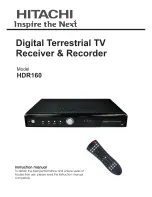
11
75
MAINTENANCE
SCAN
■
Troubleshooting
The following chart is designed to help you correct
problems which are not equipment malfunctions.
If you are unable to locate the cause of a problem or
solve it through the use of this chart, contact your near-
est Icom Dealer or Service Center.
PROBLEM
POSSIBLE CAUSE
SOLUTION
REF.
RECEIVE
POWER
TRANSMIT
Power does not come on
when the [POWER] switch
is pushed.
No sounds come out from
the speaker.
Sensitivity is too low, and
only strong signals are au-
dible.
Received audio is unclear
or distorted.
The [ANT] switch does not
function
Transmitting is impossible.
Output power is too low.
No contact possible with
another station.
Transmit signal is unclear
or distorted.
Repeater cannot be ac-
cessed.
Programmed scan does
not stop.
Programmed scan does
not start.
Memory scan does not
start
Select memory scan does
not start
• Power cable is improperly connected.
• Fuse is blown.
• Volume level is too low.
• The squelch is closed.
• The transceiver is in transmitting condition.
• The antenna is not connected properly.
• The antenna for another band is selected.
• The antenna is not properly tuned.
• The attenuator is activated.
• Wrong operating mode is selected.
• PBT function is activated.
• Noise blanker is turned ON when receiving a
strong signal.
• Preamp is activated.
• The noise reduction is activated and the [NR]
control is too far clockwise.
• The antenna switch has not been activated.
• The operating frequency is not set to a ham
band.
• [RF POWER] is set too far counterclockwise
• [MIC GAIN] is set too far counterclockwise
• The antenna for another band is selected.
• The antenna is not properly tuned.
• RIT or
∂
TX function is activated.
• Split frequency function and/or dualwatch are
activated.
• [MIC GAIN] is set too far clockwise
• Split frequency function is not activated.
• Programmed subaudible tone frequency is
wrong.
• Squelch is open.
• [RF/SQL] is assigned to RF gain control and
squelch is open.
• The same frequencies have been programmed
in scan edge memory channels P1 and P2.
• 2 or more memory channels have not been
programmed.
• 2 or more memory channels have not been
designated as select channels.
• Re-connect the DC power cable correctly.
• Check for the cause, then replace the fuse with
the spare one.
(Fuses are installed in the DC power cable and
the internal PA unit.)
• Rotate [AF] clockwise to obtain a suitable lis-
tening level.
• Turn [RF/SQL] to 10 o’clock position to open the
squelch.
• Push [TRANSMIT] to receive or check the
SEND line of an external unit, if desired.
• Re-connect to the antenna connector.
• Select an antenna suitable for the operating fre-
quency.
• Push [TUNER] for 1 sec. to manually tune the
antenna.
• Push [ATT] several times to select “ATT OFF.”
• Select a suitable operating mode.
• Push [PBT CLR] for 1 sec. to reset the function.
• Push [NB] to turn the noise blanker OFF.
• Push [P.AMP] once or twice to turn the function
OFF.
• Set the [NR] control for maximum readability.
• Set the antenna switch in set mode to “Auto” or
“Manual.”
• Set the frequency to a ham band.
• Rotate [RF POWER] clockwise.
• Set [MIC GAIN] to a suitable position.
• Select an antenna suitable for the operating fre-
quency.
• Push [TUNER] for 1 sec. to manually tune the
antenna.
• Push [RIT] or [
∂
TX] to turn the function OFF.
• Push [SPLIT] and/or [DUALWATCH] to turn the
function OFF.
• Set [MIC GAIN] to a suitable position.
• Push [SPLIT] to to turn the function ON
• Reset the frequency using set mode.
• Set [RF/SQL] to the threshold point.
• Reset [RF/SQL] control assignment and set it to
the threshold point.
• Program different frequencies in scan edge
memory channel P1 and P2.
• Program more than 2 memory channels.
• Designate more than 2 memory channels as se-
lect channels for the scan.
p. 17
p. 76
p. 2
p. 3
p. 2
—
pgs. 5,
46
p. 49
p. 5
p. 25
p. 25
p. 27
p. 5
p. 26
p. 46
p. 23
p. 3
p. 2
p. 5
p. 49
p. 6
pgs. 7,
31, 32
p. 2
p. 7
p. 47
p. 3
pgs. 3,
69
p. 53
p. 53
pgs. 52,
60












































